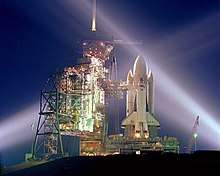Hail Columbia (film)
Hail Columbia, is an IMAX documentary film, released June 1982, about NASA's Space Shuttle program, particularly the first Space Shuttle, Columbia. The film is directed by Graeme Ferguson
| Hail Columbia | |
|---|---|
 Columbia, the shuttle featured in the film, preparing for launch | |
| Directed by | Graeme Ferguson |
| Starring | John Young Robert Crippen |
| Narrated by | James Whitmore |
Release date |
|
Running time | 37 min. |
Synopsis
The film starts off by showing the rollout and assembly of NASA's first Space-worthy Shuttle, Columbia. This involves showing in high quality, Columbia, 'the world's first true spaceship' being rolled out of the Orbiter Processing Facility, and its assembly at the Vehicle Assembly Building. Columbia is then rolled out on the Mobile Launch Platform to Launch Complex 39A. Once on the launchpad Columbia throttled up the three SSME's during a static fire, to make sure they were in working order for the launch in April 1981.
The documentary then follows John Young and Robert Crippen, who would be the Commander and Pilot for STS-1. Robert Crippen was rookie astronaut who had never been to space. John Young on the other hand, had been to space four times before. Two on Gemini and two times on missions to the moon, with one of them landing on the moon (Apollo 16). The documentary gives a nod to John Young's moon mission, which was where he was when he found out that the Space Shuttle Program had been approved.[1] The next scene shows the press conferences John and Robert had to endure as there was a lot of worry about the safety of the mission, as this was the first time humans would fly on an untested vehicle. These included worries about the SRB's and the Space Shuttles thermal protection system.
Another feature of the mission mentioned in Hail Columbia, is the escape system used by crew. As the Space Shuttle did not have a launch escape system, if anything were to go wrong on the pad, the crew would have to evacuate and use the slide wire, which was a zip line that took the crew from the Fixed Service Structure down to the surface, where the crew would either run to a bunker or climb into an M13 tank and drive away from the Shuttle.[2]
18-minutes into the documentary, the launch of STS-1 happens. The high quality sound and footage follows Columbia to SRB separation before skipping to the external tank separating. On-orbit tasks are shown off, including the opening of the payload bays and inspecting non-critical tiles which were blown loose during the launch. High quality images of the Earth are then shown off, before Columbia prepares for the descent back to Earth. The very large crowds are shown off cheering as the sonic boom of the returning Shuttle is heard.[3] Columbia then made a nominal landing at Edwards Air Force Base, where John and Robert left Columbia and greeted the waiting crowd, talking about how spectacular the mission was. The reusability of Columbia is mentioned before it is flown back to the Kennedy Space Center. The documentary fades out showing the launch of STS-2, nodding at the fact that Columbia was indeed a reusable SpaceShip.
Creating the Documentary
This documentary was unusual as it was made completely by a third party. Before hand NASA preferred to make their own documentary for scientific accuracy. Approval to fly an IMAX camera didn't end up happening until the Space Shuttle was deemed operational after STS-4. Taking a cue that the IMAX camera highly realistic experience would be able to make viewers feel like they were on the Space Shuttle, Graeme Ferguson lobbied NASA to fly an IMAX camera on the Space Shuttle. NASA was positive about the proposal as it would show off the STS program in a positive light and get the public excited. Hail Columbia was a big push to allow the IMAX camera to fly to space, due to how well the documentary had been made.[4]
The documentary was intended not to be a promotional piece for NASM, NASA, Lockheed or IMAX. The film was intended to be an educational and uplifting film about spaceflight. Following approval to fly into space in 1984, astronauts were trained how to use the camera, and it was finally flown into space on Space Shuttle Challenger on STS-41C. STS-41D (Space Shuttle Discovery) and STS-41G (Space Shuttle Challenger) were also featured in this to make the documentary, The Dream is Alive.
Release
The documentary was released in theatres on June 15, 1982. It wasn't released on disc until October 2001. The film is 37 minutes long and was the first of a string of IMAX documentaries featuring the Space Shuttle.
Impact on society
The documentary was designed to get people excited about space, particularly about the Space Shuttle which was meant to make space easily accessible and cheap for everyone. Ultimately, this never came to be due to a string of design flaws such as the Space Shuttle tiles which were damaged or broken on multiple flights including STS-1. Partially due to this, the Space Shuttle became too expensive to be a method for everyone to get to space. Despite this, due to the long life of the Shuttle, and help from IMAX documentaries, the Space Shuttle became a household name and children's favourite rocket for over three decades.
See also
References
- Liptak, Andrew (2018-01-06). "Gemini, Apollo, and Space Shuttle astronaut John Young has died". The Verge. Retrieved 2019-03-29.
- MSFC, Jennifer Wall :. "NASA - Everybody Out!". www.nasa.gov. Retrieved 2019-03-29.CS1 maint: extra punctuation (link)
- Administrator, NASA (2013-06-05). "STS-1 - The Boldest Test Flight in History". NASA. Retrieved 2019-03-29.
- Neufeld, Michale J. (2013). Spacefares. 2013: Smithsonian Institution.CS1 maint: location (link)